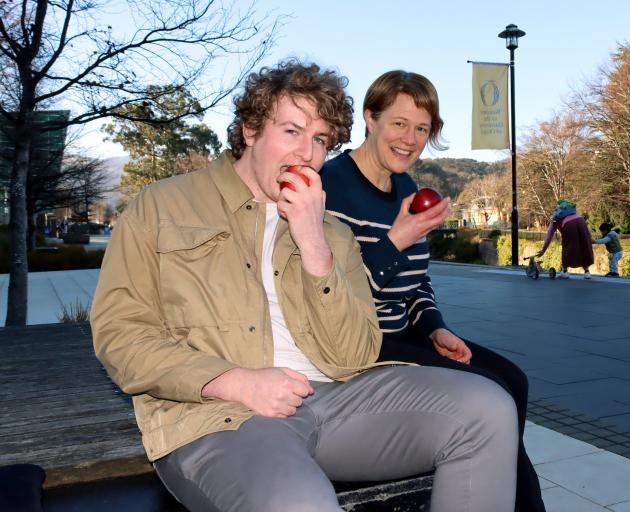Science
Research Unlocks Secrets of Heritage Apple Varieties in New Zealand

A comprehensive analysis of over 300 apple varieties from the Jim Dunckley Heritage Orchard is underway, led by Aaron Hewson, a master’s student in plant biotechnology. The orchard, established 25 years ago by the Coastal Otago Branch of the New Zealand Tree Crops Association, is considered one of New Zealand’s most diverse collections of apple cultivars. It boasts unique varieties with names such as Peasgood Nonsuch, Nonnetit Bastard, Warner’s King, and Albany Beauty.
Hewson’s research aims to facilitate the preservation and propagation of these heritage cultivars using genetic identification methods. The apple varieties were initially collected in the 1990s by Jim Dunckley from various sites across Otago and Southland, with most specimens sourced from an old Plant & Food Research orchard in Clyde. “It is a real kind of hodgepodge mix,” Hewson remarked about the diverse origins of the trees.
Some apple names, given by local farmers to reflect nearby landmarks, do not align with their genetic identities. For instance, a sample identified as Granny Smith, a popular supermarket variety, showed genetic similarities to another cultivar named Lord Lambourne. “These two cultivars should be really different, but the samples were saying they were genetically the same. So one of those names has to be wrong,” Hewson explained.
To clarify these discrepancies, samples were collected by university staff and students from the Plant Biochemistry Lab. The samples were labelled, freeze-dried, and sent to a laboratory in France for genetic analysis, a process aided by Plant & Food Research, now part of the Bioeconomy Science Institute. Hewson acknowledged the invaluable support of his co-supervisor, Dr. Elena Lopez-Girona, during this research phase. “It has been very beneficial to have her expertise,” he noted.
Using a method known as SNP chip genotyping, researchers check around 50,000 known DNA hotspots in apple leaves to create genetic fingerprints. This technique can determine whether two trees are the same variety or if they differ genetically. The local collection is particularly vital, as biosecurity regulations make it challenging to introduce new apple genetics into New Zealand. “If we talk about the entire amount of apples across the world, there are around 10,000 different varieties,” Hewson stated, adding that most commercial varieties trace back to just six apples, resulting in a narrow genetic base.
Associate Professor Lynnette Brownfield from the University of Otago, who also supervises Hewson, emphasized the significance of identifying the orchard’s cultivars. Such knowledge could assist breeders in discovering new genetic traits, including disease resistance, which would enhance future breeding programmes. The Coastal Otago Branch of the New Zealand Tree Crops Association plans to utilize the research findings to fully catalogue the trees in the orchard. This comprehensive identification will enable collaboration with apple breeders, ranging from backyard growers to larger organizations like Plant & Food Research, to provide necessary germplasm.
The ongoing research not only highlights the importance of preserving heritage apple varieties but also underscores the potential for enriching the genetic diversity of commercial apples in New Zealand. With the results of this study, the future of apple cultivation could be more sustainable and resilient.
-

 World4 months ago
World4 months agoTest Your Knowledge: Take the Herald’s Afternoon Quiz Today
-

 Sports4 months ago
Sports4 months agoPM Faces Backlash from Fans During Netball Trophy Ceremony
-

 Lifestyle4 months ago
Lifestyle4 months agoDunedin Designers Win Top Award at Hokonui Fashion Event
-

 Entertainment4 months ago
Entertainment4 months agoExperience the Excitement of ‘Chief of War’ in Oʻahu
-

 Sports4 months ago
Sports4 months agoLiam Lawson Launches New Era for Racing Bulls with Strong Start
-

 World5 months ago
World5 months agoCoalition Forms to Preserve Māori Wards in Hawke’s Bay
-

 Health4 months ago
Health4 months agoWalking Faster Offers Major Health Benefits for Older Adults
-

 Lifestyle4 months ago
Lifestyle4 months agoDisney Fan Reveals Dress Code Tips for Park Visitors
-

 Politics4 months ago
Politics4 months agoScots Rally with Humor and Music to Protest Trump’s Visit
-

 Top Stories5 months ago
Top Stories5 months agoUK and India Finalize Trade Deal to Boost Economic Ties
-

 Health2 months ago
Health2 months agoRadio Host Jay-Jay Feeney’s Partner Secures Visa to Stay in NZ
-

 World5 months ago
World5 months agoHuntly Begins Water Pipe Flushing to Resolve Brown Water Issue









